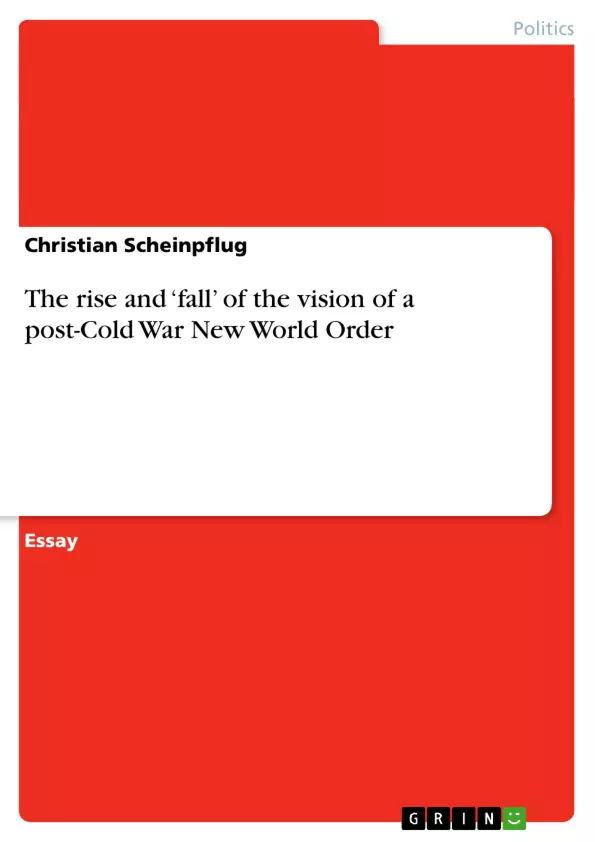On September 11, 1991, George H. W. Bush outlined the main tenets of a so-called New World Order (NWO) (Bush Sr. 1991). He did this shortly before ‘Operation Desert Storm’ commenced. After 40 years of Cold War and with Communism in its last convulsions the idea of a different, more peaceful, world, without the constant threat of nuclear holocaust or material scarcity, held much sway in international politics.
In order to properly account for the rise of such a vision, this essay uses the frames of ‘vindicationism’, developed by Jonathan Monten (2005) and ‘passive revolution’, developed by Antonio Gramsci. Two parts guide the discussion: 1) ‘Rise and Manifestation’; and 2) ‘Opposition and Entrenchment’. Subsections about the theoretical and cultural heritage of the NWO, as well as its introduction into the material world further point the way. It will emerge that the NWO is a US driven global initiative, based on cultural perception and logic of market expansion. With the help of the Chilean coup d’état in 1973, the concepts will be applied to a real world example and show how theory becomes practice. Chile 1973 was a key event that fostered the rise of a vision of New World Order, for it marked the beginning of applying theoretical concepts, developed especially by Chicago School economics, into the physical world. Those concepts thus still mark capitalist modernity. This section also paves the way for Part II. Contrary to observers who view power and the world in militaristic terms, this section argues that a vision of New World Order never fell. To underline this claim, examples such as al-Qaeda’s 9/11 attacks and China’s economic development are evaluated. During this exercise, it emerges that although both actors are seen as challenges to the US-centred world order, they are actually, in the case of al-Qaeda deviant, parts of it. The last section therefore concludes that the NWO is not new and firmly embedded in the structures of the global political economy.
Inhaltsverzeichnis (Table of Contents)
- Rise and Manifestation
- Theoretical and Cultural Heritage of the NWO
- Introduction of the NWO into the Material World
- Opposition and Entrenchment
- The Chilean Coup d’état of 1973
- 9/11 and China’s Economic Development
Zielsetzung und Themenschwerpunkte (Objectives and Key Themes)
This essay examines the rise and continued presence of the New World Order (NWO) vision, particularly in the context of the post-Cold War era. It aims to analyze the theoretical foundations and practical manifestations of the NWO, drawing upon concepts like vindicationism and passive revolution. The essay explores how the NWO, driven by US-centric interests and the logic of market expansion, seeks to shape the world in a liberal image.
- The emergence and evolution of the New World Order (NWO) concept
- The influence of US foreign policy and economic interests in shaping the NWO
- The role of free-market capitalism and its underlying logic of circulation and production
- The concept of vindicationism as a moral justification for US global influence
- The application of passive revolution as a strategy for implementing NWO ideals
Zusammenfassung der Kapitel (Chapter Summaries)
The first part of the essay examines the rise and manifestation of the NWO vision, outlining its theoretical and cultural heritage. It explores how the US, emboldened by the fall of communism and driven by a belief in the market's ability to spread freedom and prosperity, sought to establish its dominance on the world stage. The essay introduces the concept of vindicationism, which serves as a moral justification for US influence, emphasizing its belief in liberal values and its view of US intervention as inherently beneficial. The chapter also delves into the concept of passive revolution, which explains how NWO ideals are implemented in the real world, citing the 1973 Chilean coup d’état as a practical example.
Schlüsselwörter (Keywords)
The main keywords and focus topics of the text include: New World Order, US foreign policy, free-market capitalism, vindicationism, passive revolution, Chilean coup d’état, globalization, liberal ideology, neoliberalism, power, hegemony, and international relations. The essay explores these concepts within the context of the post-Cold War era, analyzing the interplay between theory and practice, as well as the enduring influence of the NWO vision on the contemporary global political economy.
- Quote paper
- Christian Scheinpflug (Author), 2013, The rise and ‘fall’ of the vision of a post-Cold War New World Order, Munich, GRIN Verlag, https://www.grin.com/document/268137



